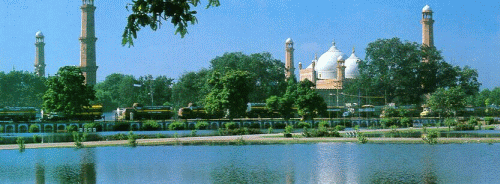
Beautiful View of Baadshahi Mosque Lahore-Pakistan
Dr.Mazhar Naqvi
There is striking similarity between Jama Masjid of Delhi and Lahore
based Baadshahi Mosque. Both were built by Mughal Emperors and houses sacred relics
of the Holy Prophet, Hazrat Ali and Bibi Fatima Zahra. Like Jama Masjid, awareness
about the existence of relics at Baadshahi mosque is also little. While holy
relics at Jama Masjid has never been stolen, Baadshahi mosque was in news when
a pair of prophet’s slippers was reported missing from its small museum. The
relic has so far not been recovered and people strongly believe that it was
sold to Sultan of Brunei at a hefty amount by the perpetrators of meticulously
planned and executed theft. After the incident, Punjab Government had decided
to shift all the relics to Lahore museum but later on dropped the idea on the
ground that better security was a better solution to check reoccurrence of any
such theft.
It is said that these relics were brought to India by Taimur Lang.
Mughal Emperors had inherited them as his descendants. During Sikh rule, a
number of artifacts’ were removed from Lahore Fort and Baadshahi Mosque to
Amritsar but Maharaja Ranjit Singh did not touch the relics. He kept them safe
in his treasury. After partition, Pakistan government became caretaker of the
relics. The major relics include turban of the Prophet, two more pairs of
slippers worn by the last messenger and his sacred hair. Other relics belonged
to Maula Ali and Bibi Fatima Zahra. The government has a list containing the details
of all the relics.
The Baadshahi Mosque was built in 1673 by Emperor
Aurangzeb. It is one of Lahore’s best known landmarks. Capable to accommodate
over 55,000 worshippers, the design of the Baadshahi Masjid is closely resembles
to Jama Masjid in Delhi. Its construction was completed in a record time of two and a
half years. The mosque is entirely made of marble and red sand stone. Its main
entrance measures 21.33 meters in length and a courtyard of 161.5 x 160.6
meters. The marble domes cover seven prayer chambers, surrounded by four
minarets at the four corners of the mosque, each with an outer circumference of
20 meters, soaring up to 54 meters. The walls and roofs of the prayer halls
have tastefully decorated with Islamic calligraphy, traditional Persian tile
sheathing and fresco. The use of stone and marble for exteriors and
interiors lends the mosque a solid monumentality.
No comments:
Post a Comment